25 years of the Sega Saturn: Part 2-The Two-Pronged Stumble
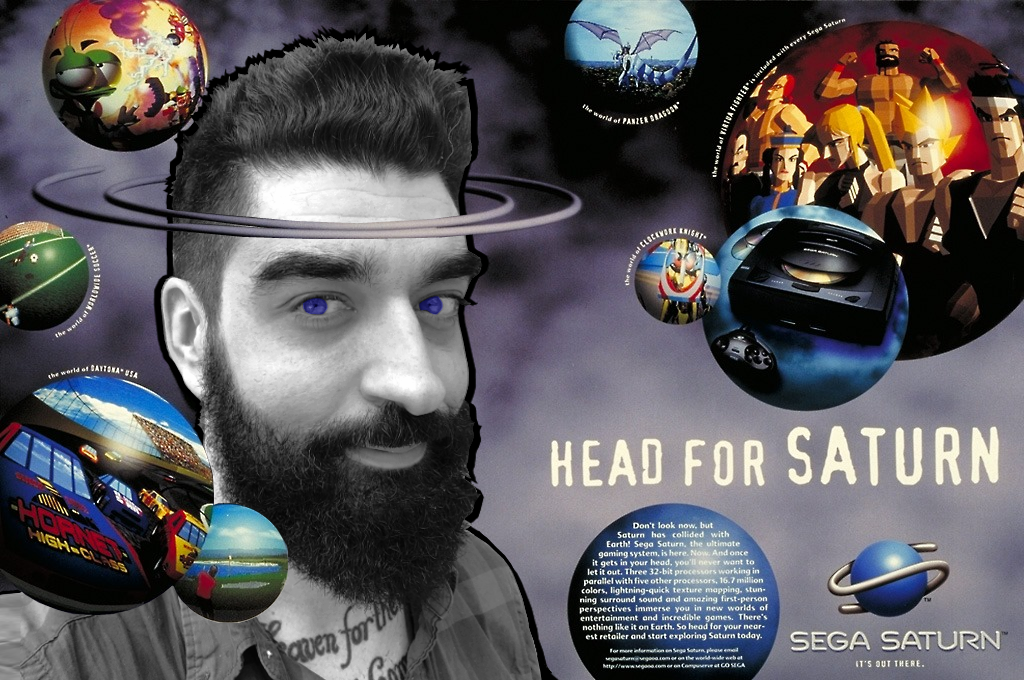
 ell, this is embarrassing; I had planned to publish this entry much sooner than now, given that it’s been a little over a year since I last published the premier piece to this editorial series, but I suppose it’s appropriate since we’ve now arrived at the anniversary of SEGA’s polarizing 32-bit powerhouse once more.
ell, this is embarrassing; I had planned to publish this entry much sooner than now, given that it’s been a little over a year since I last published the premier piece to this editorial series, but I suppose it’s appropriate since we’ve now arrived at the anniversary of SEGA’s polarizing 32-bit powerhouse once more.
When we last left off, we looked at the pre-launch hype of the Saturn and SEGA’s internal dissension over the mechanical complexity of the hardware, with technical specs that were arguably geared more at enhancing the present climate of gaming than preparing for the next dimension of gameplay the medium had been building to. The corporate disconnection only grew from there as SEGA of Japan hedged all their bets on the console with one fateful announcement during their 1995 Electronic Entertainment Expo presentation—the Sega Saturn was available now, retailing at $399 MSRP with the inclusion of Virtua Fighter to the surprise of everyone, including major retailers.
It was with this first big step that the Sega Saturn had begun its perpetual tumble towards commercial failure, as we look back at one of the most infamously mismanaged console launches in Video Game History.
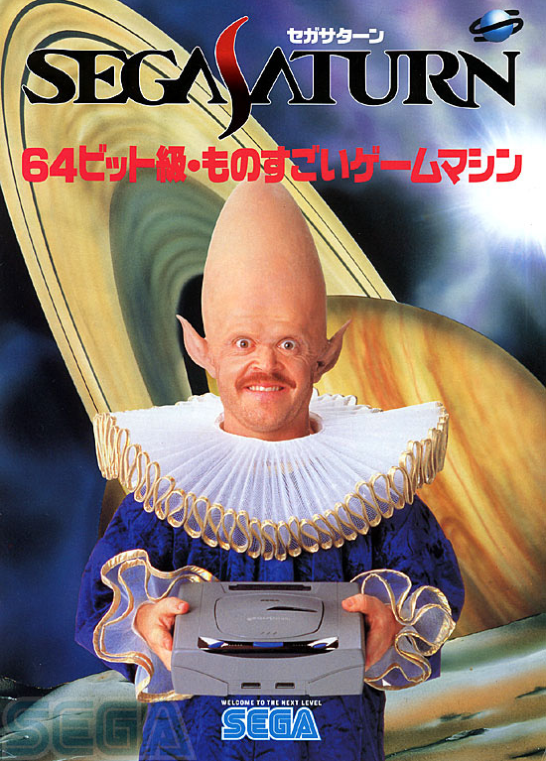 What makes the whiplash of the Sega Saturn’s spontaneous Launch date all the more tragic was the fleeting sense of harmony the company had just reached between their corporate branches shortly after the system’s 1994 Holiday launch in Japan. Delivering the same bundle, the Saturn was able to sell out of their initial wave of 200,000 units, outpacing the PlayStation’s subsequent Japanese launch by 100,000 before beating it out by a sizable margin of 500,000 sold to the PlayStation’s 300,000 at the end of 1994. The lack of third-party software at launch made the lead all the more impressive with Virtua Fighter being the only killer app to available the unit aside from Wan Chai Connection, a competent, but admittedly underwhelming first-person mystery adventure game using real-life photo visuals.
What makes the whiplash of the Sega Saturn’s spontaneous Launch date all the more tragic was the fleeting sense of harmony the company had just reached between their corporate branches shortly after the system’s 1994 Holiday launch in Japan. Delivering the same bundle, the Saturn was able to sell out of their initial wave of 200,000 units, outpacing the PlayStation’s subsequent Japanese launch by 100,000 before beating it out by a sizable margin of 500,000 sold to the PlayStation’s 300,000 at the end of 1994. The lack of third-party software at launch made the lead all the more impressive with Virtua Fighter being the only killer app to available the unit aside from Wan Chai Connection, a competent, but admittedly underwhelming first-person mystery adventure game using real-life photo visuals.
Taking this lead to heart, Tom Kalinske of SEGA of America coordinated an initial plan to launch the Sega Saturn on September 2nd of 1995, where the system would be able to launch with a significantly larger lineup of titles. This planned wave of games included Team Andromeda’s Panzer Dragoon, SEGA’s Clockwork Knight, and one of the first Western developed titles for the console, BUG! along with a slew of other titles not too far behind like Astal and Fighting Vipers. Instead of staying on that path, however, SEGA of America found themselves at the end of another war of attrition with their Japanese counterpart over the management of the Saturn, and it upcoming launch
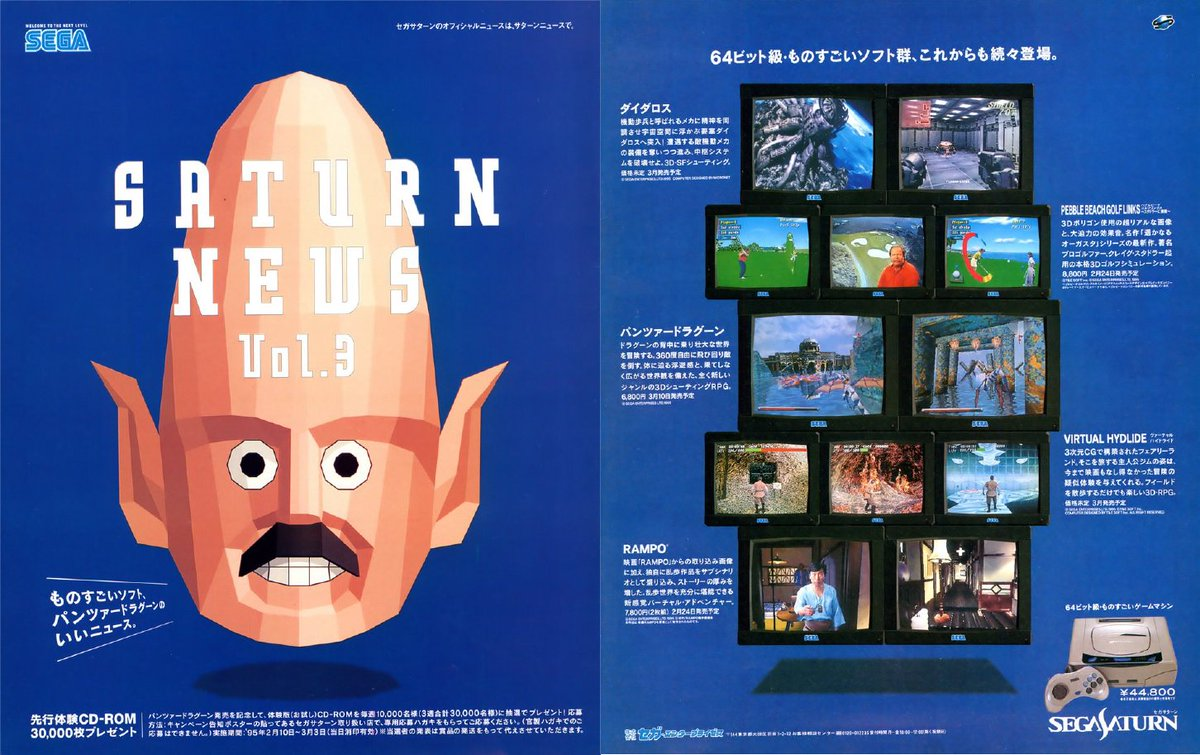
With tensions running high over the marginal headstart they had over Sony gradually closing, SEGA of Japan felt that the only way the Saturn could maintain its momentum is if the system were to launch ahead of schedule in other territories to help widen the sales gap with Sony again. This plan of action was made with the intent that it would hold off until their gamble of the Saturn’s imminent premium exclusives generating enough crucial general interest from the mass market could pay off. As was the case with most of the major decisions on the Saturn’s development, Kalinske and company were not pleased with the SEGA of Japan’s hastiness. In a recent interview with Game Informer, Kalinske recalled the confrontation he had over the matter with SEGA CEO, Hayao Nakayama, “When we were going to launch it in the fall, I thought that was too early; I wanted to put it off until the following year,” he says. “This was one of the main reasons I left Sega. Nakayama was so concerned over Sony launching a hardware platform that he wanted to beat them to the punch.” SEGA of America’s protests were made in vain as Nakayama pressured Kalinske into taking the stage with the May 11th launch date, the American branch president salvaged the move the best he could with a presentation that leaned into the imprudent effort. Boasting the ambitious hardware specs and capabilities, Tom Kalinske deployed the now-infamous PR stunt that he had hoped would help the Saturn—a same-day launch.
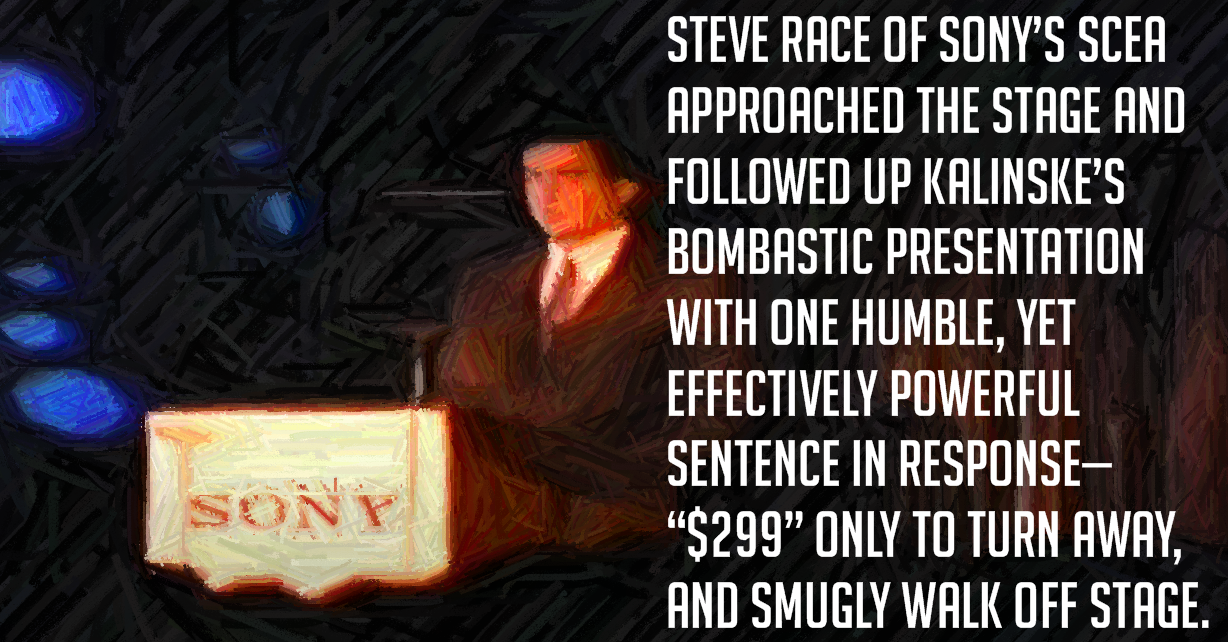
The idea behind rushing to market was to capitalize on the buzz of the move would draw around to their new console, as he then went on to boast that they had already shipped over 30,000 units to select retailors for sale right now, at a price point of $399.99 out the door. In addition to the base set, SEGA also launched a $449 set bundled with Virtua Fighter, and five other launch titles; Clockwork Knight, Daytona USA, Panzer Dragoon, Pebble Beach Golf Links, and Worldwide Soccer: Sega International Victory Goal Edition. While the selection of games did have some heavy-hitters among them like Panzer Dragoon and Clockwork Knight, there were still a number of issues that rained on any chances of success the Saturn launch could have hoped for.
The energy that SEGA put into staying ahead of Sony backfired in a major way as the Japanese Electronics giant followed up on the Saturn’s jaw-dropping Launch announcement with one of their own. Steve Race of Sony’s SCEA approached the stage and followed up Kalinske’s bombastic presentation with one humble, yet effectively powerful sentence in response—“$299” only to turn away, and smugly walk off stage. Getting undercut by their direct competitor was one thing, but setting up the Saturn for the same-day launch was also bullet to the foot within itself.
The surprise announcement didn’t just take the public off guard—it shocked the entire industry with developers, retailers, and media getting first wind of the abrupt release as well—causing a multitude of complications for the initial performance of the new console. Among the major retailers carrying the Saturn and its software were Babbage's, Electronics Boutique, and Toys "R" Us, with most stores were allocated as little as 8 units or less—and that’s not to account for the scrambled shipments that didn’t make their way onto shelves with other retailers like Walmart and Best Buy. Some stores like K·B Toys, felt betrayed by the decision, and cut ties with carrying anything SEGA altogether—but the splintering supply was only the beginning. The move overestimated just how much penetration the hype of Saturn’s buildup had in mainstream media. As popular as the Sega Genesis, the machine had barely made SEGA into a household name, not to mention the gaming space was starting to crowd up again with the likes of Atari and 3DO getting thrown into the ring—word of mouth could only carry the anticipation of the SEGA’s new hardware so far in the overall market space. Without the advantage of something like the internet, breaking news as important as the surprise launch of next-generation hardware for the time was no small-task, and Video Games weren’t big enough to get the new rub from media giants like CNN, NBC, or FOX at the time, hurting any chance for momentum the system could get all the more.
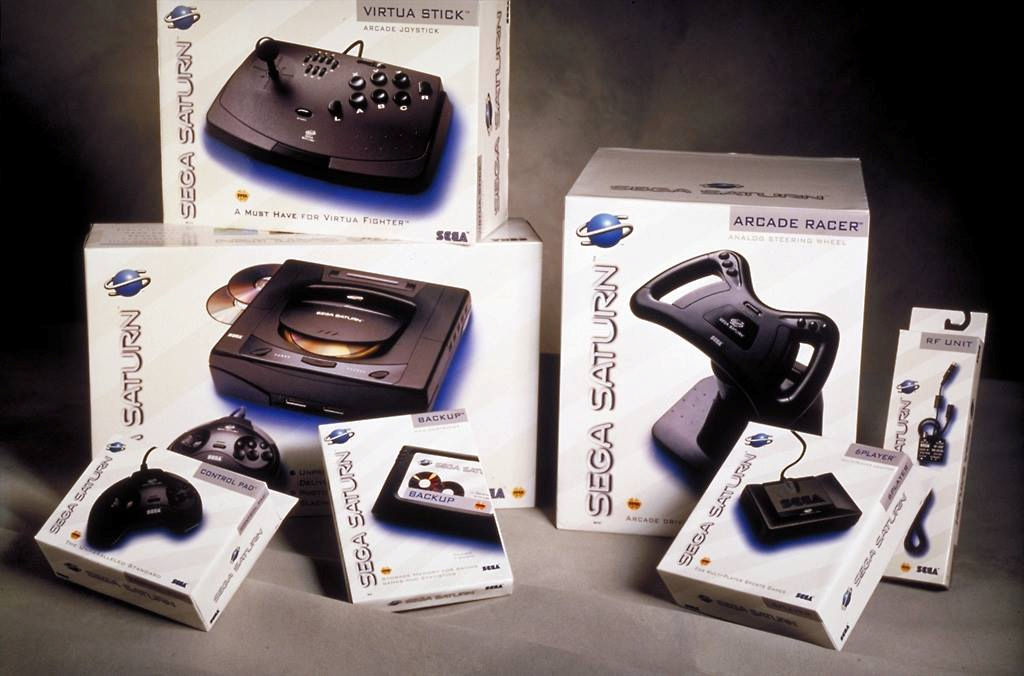 Over 30,000 units and load of other accessories were sent to different retailers to sell without a single notice from SEGA
Over 30,000 units and load of other accessories were sent to different retailers to sell without a single notice from SEGA
Needless to say this didn’t stop SEGA from launching a fifty-million dollar marketing campaign to shove anything and everything Saturn down the throats of every consumer they could, the keyword being “consumer” because the bizarre “Head for Saturn” slogan certainly wasn’t aimed at the interests of impressionable children
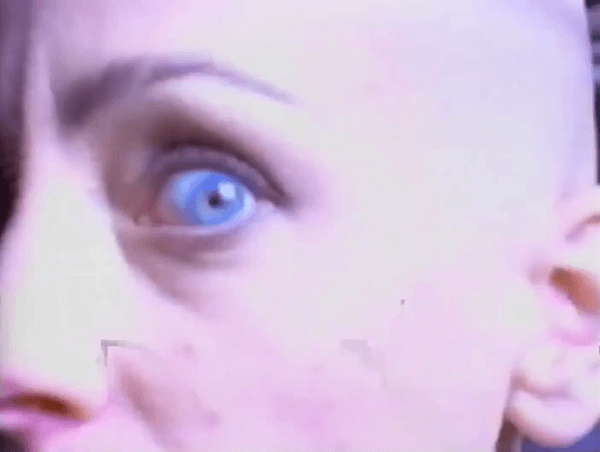 Before Segata Sanshiro beat the ever-living hell out of everyone he stumbled across into submitting their love for the Sega Saturn, the Galaxy-Brains (see what I did there) over at Sega of America took the Interstellar theme of the hardware to heart with a wave of weird-ass commercials and print ads. These marketing ploys could only be best described as New Wave Music video production meets Outer Space bullshit. In fact, before we even get there, let’s just look at this horrifying sizzle reel, narrated by a disembodied head that looks like the dumpster baby of George Foreman, and Zordon from Mighty Morphin’ Power Rangers. The creepy floating cranium challenges gamers to “play their games in the 21st Century, and leave the rest of the world behind” with, and I quote, “twenty Spleen-busting games at launch,” a statement that was founded upon the original September date instead of the May launch SEGA of America ended up blundering onto. Post-launch, SoA took Style over Substance to a whole new meaning with a slew of over-the-top advertisements that focused more on spectacle than promotion. Saturn print ads had published several appearances of a pale bald woman with planetoid rings orbiting her head, accompanied by various screenshots of Saturn software that was displayed through a fish-eyed perspective on a sphere-shaped frame.
Before Segata Sanshiro beat the ever-living hell out of everyone he stumbled across into submitting their love for the Sega Saturn, the Galaxy-Brains (see what I did there) over at Sega of America took the Interstellar theme of the hardware to heart with a wave of weird-ass commercials and print ads. These marketing ploys could only be best described as New Wave Music video production meets Outer Space bullshit. In fact, before we even get there, let’s just look at this horrifying sizzle reel, narrated by a disembodied head that looks like the dumpster baby of George Foreman, and Zordon from Mighty Morphin’ Power Rangers. The creepy floating cranium challenges gamers to “play their games in the 21st Century, and leave the rest of the world behind” with, and I quote, “twenty Spleen-busting games at launch,” a statement that was founded upon the original September date instead of the May launch SEGA of America ended up blundering onto. Post-launch, SoA took Style over Substance to a whole new meaning with a slew of over-the-top advertisements that focused more on spectacle than promotion. Saturn print ads had published several appearances of a pale bald woman with planetoid rings orbiting her head, accompanied by various screenshots of Saturn software that was displayed through a fish-eyed perspective on a sphere-shaped frame.
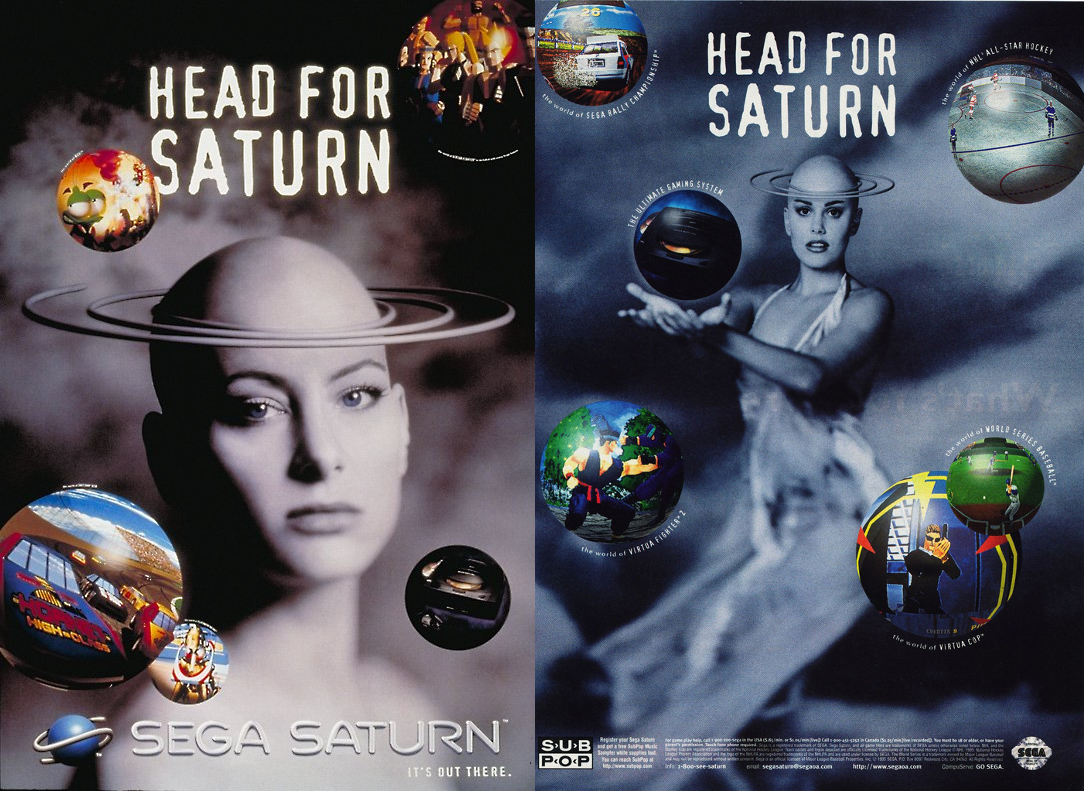
While the puff pieces were certainly eye-catching, they did little to actually show off any worthwhile exposure of the games, though we did get a cameo from rapper-turned-actor, Ice Cube in one placement, throwing some heavy endorsement onto the 32-bit console. Television commercials didn’t take the space gimmick too literally and opted for a creative license that was more reminiscent of the late-era Sega Genesis commercial blitzes the public had come to know and love. The “Eye of the Theater” advert opened to an up-close angle of a human eye that would then zoom pan to a metropolitan movie theater, smash-cutting to a crowded showing room filled with a mob of yammering robed men, each labeled with a bodily function of the brain. These old goons would then dramatically respond to the montage of Saturn games on-screen with what I could only guess to be “mental sensations” before the advert spontaneously ends back on that same eye then rolling back its iris into the shape of the Saturn logo.
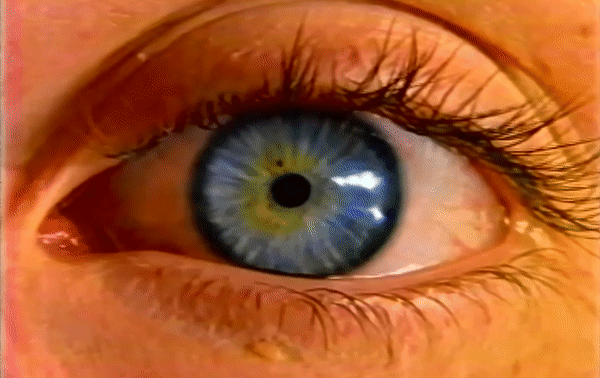 The company also fell back into their habit on punching down on the competition, specifically taking aim at Sony, who had embarrassed the Saturn’s E3 premier, mainly targeting the PlayStation’s single processor to the Saturn’s dual-processor, the one thing that ironically enough gave the Saturn so much trouble behind-the-scenes for its R&D. The Japanese gaming giant didn’t ignore its old adversary though, as they also pushed a snow-job on the Big N’s meager two-game launch lineup, mocking them with the name “Pretendo” like it was the greatest Rib since Baby Back. The move may have seemed great on paper, but it ended up looking really silly when one of those games they were mocking went on to be one of the most important 3D video Games of all time. Slinging mud only got SEGA so far, pushing the Western branch to take more drastic measures with the system’s image. Although their marketing was always edgy, the direction that Sega of America went with on for their Hitachi-powered monster punched above a weight-class that wasn’t even its league, and it didn’t take long before their marketing efforts would cross over into obscenely adulterated territory
The company also fell back into their habit on punching down on the competition, specifically taking aim at Sony, who had embarrassed the Saturn’s E3 premier, mainly targeting the PlayStation’s single processor to the Saturn’s dual-processor, the one thing that ironically enough gave the Saturn so much trouble behind-the-scenes for its R&D. The Japanese gaming giant didn’t ignore its old adversary though, as they also pushed a snow-job on the Big N’s meager two-game launch lineup, mocking them with the name “Pretendo” like it was the greatest Rib since Baby Back. The move may have seemed great on paper, but it ended up looking really silly when one of those games they were mocking went on to be one of the most important 3D video Games of all time. Slinging mud only got SEGA so far, pushing the Western branch to take more drastic measures with the system’s image. Although their marketing was always edgy, the direction that Sega of America went with on for their Hitachi-powered monster punched above a weight-class that wasn’t even its league, and it didn’t take long before their marketing efforts would cross over into obscenely adulterated territory
In one of their more notorious Ads, Sega had promoted assorted Saturn games coming out for the system with screenshots that barely obscured the sexual regions of a naked female model, boldly imposing the statement “In case you didn’t notice, there is a BEAUTIFUL NAKED WOMAN on this page” across the Ad for extra effect. Even though Video Games had unfortunately thrived on misogyny in the 90’s, the advert still drew the ire for being the objectifying garbage that it was. In a quote for The Most Controversial Video Game Ads of All Time, former Managing Editor of GamePro Media, Mike Weigand, said “This is probably the most controversial advertisement to ever run in GamePro, and it came straight from Sega’s marketing department. Readers pelted the GamePro editors with hate mail and threatened to cancel their subscriptions when this two-page centerfold ran in 1996 promoting the Sega Saturn gaming system. It didn’t do Sega any good, though, as the Saturn crashed and burned once Sony moved into position with the PlayStation. Take note: sexy ad campaigns do not a successful next-gen console make.” At some point after this debacle, Sega of America had wisely toned down the shock-factor of their Ad-space but the transition was arguably too late. A lot of the gambles they had taken with the system in terms of their exclusive lineup, and the company’s baffling effort to elevate their presence in the fifth generation of Video Games had bankrupted a fair share of the public’s goodwill towards SEGA.
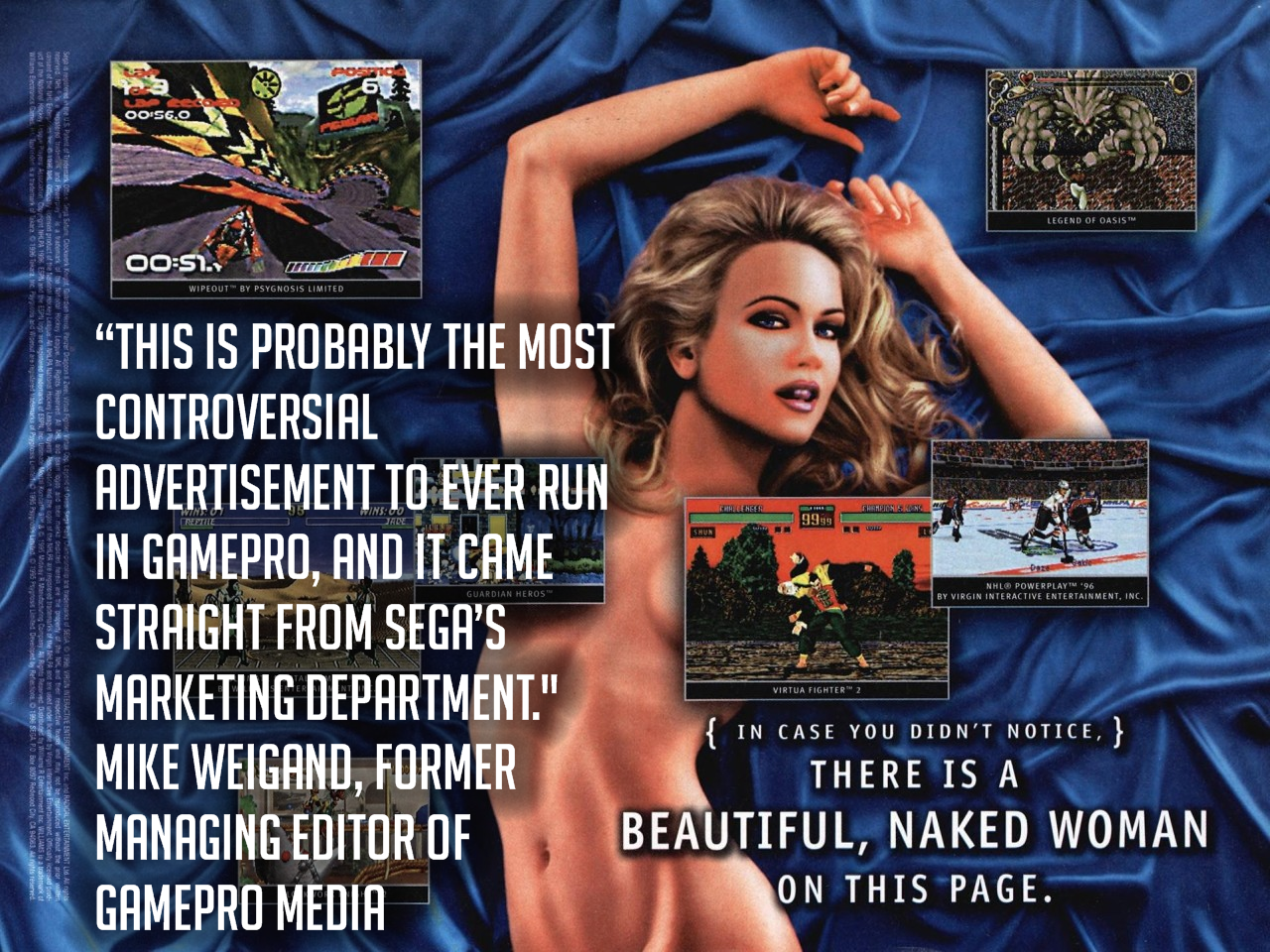
The promotion of late-era Sega Saturn veered more towards the “Gen-X” crowd with edgy bumpers of the Sega Saturn Planetoid logo mutating to a male teenager with a Liberty-Spike haircut and Safety-Pin pierced through his septum yelling the trademark “SAYGAH” shout to cap off the commercial. Doubling back on “Raging Arcade Gameplay” and “The Most Authentic Sports Games” only got the system so far in the hivemind of the Mid-Nineties gaming scene, with business decisions that would only manage to backfire on the Saturn harder than the last one.
In the next chapter of our 25 years of the Sega Saturn feature, we’ll be examining the North American library under a microscope. Not only will we look at the titles that did make it over to the states under the watch of a one, Bernie Stolar, but we’ll also dive into the absence of a certain Blue Hedgehog whose appearance could have made all the difference against the Saturn’s untimely demise.
Buckle up for that installment kids, because it turns out that old white men aren’t just clueless at running the United States—they also happen to know dick all about Video games too.
 1994,
1994,  Clockwork Knight,
Clockwork Knight,  E3 1995,
E3 1995,  Head for Saturn,
Head for Saturn,  Panzer Dragoon,
Panzer Dragoon,  Sega,
Sega,  Sega Saturn,
Sega Saturn,  Steve Race,
Steve Race,  Tom Kalinske,
Tom Kalinske,  Virtua Fighter | in
Virtua Fighter | in  Features
Features 









